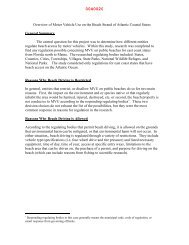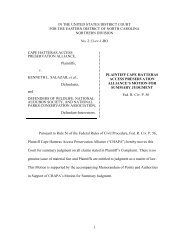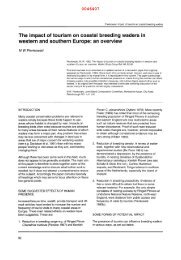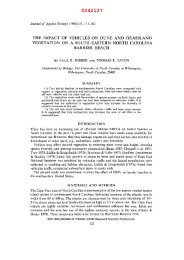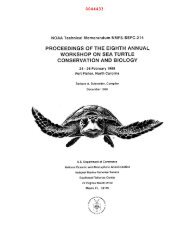Level Rise - Outer Banks Preservation Association
Level Rise - Outer Banks Preservation Association
Level Rise - Outer Banks Preservation Association
Create successful ePaper yourself
Turn your PDF publications into a flip-book with our unique Google optimized e-Paper software.
0056633where, a = geomorphology, b = shoreline erosion/accretion rate, c = coastal slope, d =relative sea-level riserate, e = mean significant wave height, and f = mean tide range. The calculated CVI value is then divided intoquartile ranges to highlight different vulnerabilities within the park. The numeric CVI values that correspond to aspecific vulnerability index (low - very high) are unique to Cape Hatteras National Seashore, and are not comparableto CVI ranges in other parks where the CVI has been employed (i.e., very high vulnerability means the same amongparks; it's the numeric values that differ, such that a numeric value that equals very high vulnerability in one parkmay equal moderate vulnerability in another). To compare vulnerability among coastal parks, the national-scalestudies should be used (Thieler and Hammar-Klose, 1999, 2000a, and 2000b). This approach best describes andhighlights the vulnerability specific to each park.ResultsThe calculated CVI values for Cape Hatteras range from 18.26 to 51.03. The mean CVI value is 37.64; themode is 45.64 and the median 36.5. The standard deviation is 7.5. The 25th, 50th, and 75th percentiles are 32.0,36.0, and 42.0, respectively.Figure 14 shows a map of the CVI (vulnerability ranges) for Cape Hatteras National Seashore. The CVI scores aredivided into low, moderate, high, and very high-vulnerability categories based on the quartile ranges and visualinspection of the data. CVI values below 32.0 are assigned to the low vulnerability category. Values from 32.0-36.0are considered moderate vulnerability. High-vulnerability values lie between 36.01 and 42.0.CVI values above 42.0 are classified as very high vulnerability. Figure 14 shows a histogram of thepercentage of CAHA shoreline in each vulnerability category. Nearly 195 km (120 miles) of shoreline is evaluatedalong the <strong>Outer</strong> <strong>Banks</strong>. Of this total, 27 percent of the mapped shoreline is classified as being at very highvulnerability due to future sea-level rise. Another 27 percent is classified as high vulnerability, 30 percent asmoderate vulnerability, and sixteen percent as low vulnerability.DiscussionThe data within the CVI show variability at different spatial scales (Figure 13). However, the ranked valuesfor the physical process variables vary little over the extent of the shoreline. The value of the relative sea-level risevariable is constant at very high vulnerability for the entire study area. The significant wave height vulnerability isvery high to high, and the tidal range is very high vulnerability.The geologic variables show greater variability and thus have the most influence on the CVI value andranges (Figure 13). Geomorphology in the park includes high vulnerability barrier island shoreline with dune ridgesseparated by very high vulnerability washover-dominated low areas. Vulnerability assessment based on historicalshoreline change trends varies from very low to very high (Figure 12 A -D). Regional coastal slope is mostly in thevery high vulnerability range with a few high vulnerability slope areas.The most influential variables in the CVI are geomorphology, shoreline change, regional coastal slope andsignificant wave height; therefore they may be considered the dominant factors controlling how Cape Hatteras willevolve as sea level rises. Geomorphology, coastal slope, and significant wave height only vary between high andvery high vulnerability, whereas shoreline change ranges from very low to very high.Because of the importance of habitat and the dynamic nature of the <strong>Outer</strong> <strong>Banks</strong>, concern about erosion,storm surge breaching of the barriers, future sea-level rise, and mainland flooding, planning is underway by private,federal, and state agencies to address these issues. Alternatives such as large-scale nourishment of the beach anddunes along Cape Hatteras are being considered. Implementation of future beach nourishment could alter the CVIresults presented here.6



